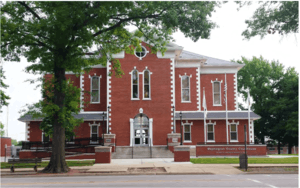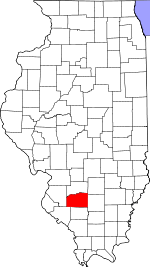Washington County, Illinois
Washington County is a county located in the U.S. state of Illinois. According to the 2010 census, it had a population of 14,716.[1] Its county seat is Nashville.[2] It is located in the southern portion of Illinois known locally as "Little Egypt".
Washington County | |
|---|---|
 Washington County Courthouse in Nashville | |
 Seal | |
 Location within the U.S. state of Illinois | |
 Illinois's location within the U.S. | |
| Coordinates: 38°21′N 89°25′W | |
| Country | |
| State | |
| Founded | January 2, 1818 |
| Named for | George Washington |
| Seat | Nashville |
| Largest city | Nashville |
| Area | |
| • Total | 564 sq mi (1,460 km2) |
| • Land | 563 sq mi (1,460 km2) |
| • Water | 1.3 sq mi (3 km2) 0.2% |
| Population (2010) | |
| • Total | 14,716 |
| • Estimate (2018) | 13,995 |
| • Density | 26/sq mi (10/km2) |
| Time zone | UTC−6 (Central) |
| • Summer (DST) | UTC−5 (CDT) |
| Congressional district | 15th |
| Website | www |
History
Washington County was formed on January 2, 1818 out of St. Clair County. It was named for George Washington. Despite its relative proximity to the Illinois suburbs of St. Louis, Missouri, the county is not considered part of the St. Louis metropolitan area, also known as the Metro-East. In 1813, the Lively Massacre occurred near Little Crooked Creek. In 1959, the state established the Washington County State Recreation Area.[3] Washington County was initially settled by immigrants from Kentucky who moved northward out of that state in the early 1800s. In the late 1800s there were (relatively) large numbers of immigrants who settled in Washington County, and by the early 1900s there were large numbers of first-generation immigrants still living in Washington County. They primarily came from the four countries of Germany, Poland, Ireland and England.[4]
 Washington County from its 1818 creation to 1824
Washington County from its 1818 creation to 1824 Washington County in 1824, reduced to its current borders by the creation of Clinton County
Washington County in 1824, reduced to its current borders by the creation of Clinton County
Geography
According to the U.S. Census Bureau, the county has a total area of 564 square miles (1,460 km2), of which 563 square miles (1,460 km2) is land and 1.3 square miles (3.4 km2) (0.2%) is water.[5] There are many lakes, rivers, streams, and creeks in this area, including the Kaskaskia River, which is the county's northern border.
Climate and weather
| Nashville, Illinois | ||||||||||||||||||||||||||||||||||||||||||||||||||||||||||||
|---|---|---|---|---|---|---|---|---|---|---|---|---|---|---|---|---|---|---|---|---|---|---|---|---|---|---|---|---|---|---|---|---|---|---|---|---|---|---|---|---|---|---|---|---|---|---|---|---|---|---|---|---|---|---|---|---|---|---|---|---|
| Climate chart (explanation) | ||||||||||||||||||||||||||||||||||||||||||||||||||||||||||||
| ||||||||||||||||||||||||||||||||||||||||||||||||||||||||||||
| ||||||||||||||||||||||||||||||||||||||||||||||||||||||||||||
In recent years, average temperatures in Nashville have ranged from a low of 22 °F (−6 °C) in January to a high of 88 °F (31 °C) in July, although a record low of −21 °F (−29 °C) was recorded in December 1989 and a record high of 106 °F (41 °C) was recorded in July 1980. Average monthly precipitation ranged from 2.18 inches (55 mm) in January to 4.10 inches (104 mm) in May.[6] On November 17, 2013, an EF4 tornado swept through the area, destroying homes and causing two fatalities.
Major highways
Adjacent counties
- Clinton County (north)
- Marion County (northeast)
- Jefferson County (east)
- Perry County (south)
- Randolph County (southwest)
- St. Clair County (west)
Demographics
| Historical population | |||
|---|---|---|---|
| Census | Pop. | %± | |
| 1820 | 1,517 | — | |
| 1830 | 1,675 | 10.4% | |
| 1840 | 4,810 | 187.2% | |
| 1850 | 6,953 | 44.6% | |
| 1860 | 13,731 | 97.5% | |
| 1870 | 17,599 | 28.2% | |
| 1880 | 21,112 | 20.0% | |
| 1890 | 19,262 | −8.8% | |
| 1900 | 19,526 | 1.4% | |
| 1910 | 18,759 | −3.9% | |
| 1920 | 18,035 | −3.9% | |
| 1930 | 16,286 | −9.7% | |
| 1940 | 15,801 | −3.0% | |
| 1950 | 14,460 | −8.5% | |
| 1960 | 13,569 | −6.2% | |
| 1970 | 13,780 | 1.6% | |
| 1980 | 15,472 | 12.3% | |
| 1990 | 14,965 | −3.3% | |
| 2000 | 15,148 | 1.2% | |
| 2010 | 14,716 | −2.9% | |
| Est. 2018 | 13,995 | [7] | −4.9% |
| U.S. Decennial Census[8] 1790-1960[9] 1900-1990[10] 1990-2000[11] 2010-2013[1] | |||
As of the 2010 United States Census, there were 14,716 people, 5,926 households, and 4,112 families residing in the county.[12] The population density was 26.2 inhabitants per square mile (10.1/km2). There were 6,534 housing units at an average density of 11.6 per square mile (4.5/km2).[5] The racial makeup of the county was 97.7% white, 0.7% black or African American, 0.3% Asian, 0.1% American Indian, 0.4% from other races, and 0.8% from two or more races. Those of Hispanic or Latino origin made up 1.3% of the population.[12] In terms of ancestry, 53.6% were German, 14.0% were Polish, 13.1% were Irish, 7.7% were English, and 6.1% were American.[13]
Of the 5,926 households, 30.1% had children under the age of 18 living with them, 57.6% were married couples living together, 7.3% had a female householder with no husband present, 30.6% were non-families, and 25.9% of all households were made up of individuals. The average household size was 2.44 and the average family size was 2.93. The median age was 42.3 years.[12]
The median income for a household in the county was $51,440 and the median income for a family was $64,171. Males had a median income of $44,272 versus $30,683 for females. The per capita income for the county was $24,846. About 5.5% of families and 9.1% of the population were below the poverty line, including 13.2% of those under age 18 and 8.9% of those age 65 or over.[14]
Education
The county is served by six school districts:[15]
- Oakdale CCSD 1
- West Washington County CUD 10
- Irvington CCSD 11
- Ashley CCSD 15
- Nashville CCSD 49
- Nashville Community High School District 99
Communities
Unincorporated communities
Politics
Washington is a rural conservative county in Southern Illinois that has always trended Republican in presidential elections. The only Democrat to win a majority of the county's ballots since the Civil War was Franklin D. Roosevelt in his 1932 landslide. Historically, the county was dominated by organized labor and family farms. The area tends to be economically and socially conservative.
| Year | Republican | Democratic | Third parties |
|---|---|---|---|
| 2016 | 74.9% 5,571 | 19.5% 1,448 | 5.6% 419 |
| 2012 | 64.5% 4,792 | 33.0% 2,450 | 2.6% 193 |
| 2008 | 56.4% 4,473 | 42.1% 3,342 | 1.5% 117 |
| 2004 | 62.6% 5,072 | 36.9% 2,986 | 0.6% 46 |
| 2000 | 61.0% 4,353 | 37.0% 2,638 | 2.1% 147 |
| 1996 | 48.2% 3,339 | 39.6% 2,744 | 12.2% 844 |
| 1992 | 39.8% 3,003 | 39.5% 2,986 | 20.7% 1,566 |
| 1988 | 60.0% 4,127 | 39.1% 2,689 | 0.8% 58 |
| 1984 | 68.2% 5,129 | 31.4% 2,363 | 0.3% 24 |
| 1980 | 69.0% 5,354 | 27.8% 2,158 | 3.2% 250 |
| 1976 | 57.2% 4,485 | 41.1% 3,222 | 1.8% 137 |
| 1972 | 68.9% 5,179 | 30.9% 2,327 | 0.2% 16 |
| 1968 | 63.3% 4,793 | 27.7% 2,093 | 9.0% 683 |
| 1964 | 51.1% 3,840 | 48.9% 3,670 | 0.0% 0 |
| 1960 | 62.0% 5,053 | 37.9% 3,093 | 0.1% 11 |
| 1956 | 65.1% 5,299 | 34.7% 2,820 | 0.2% 16 |
| 1952 | 66.2% 5,546 | 33.7% 2,824 | 0.1% 11 |
| 1948 | 62.0% 4,544 | 37.3% 2,737 | 0.7% 49 |
| 1944 | 66.3% 5,428 | 33.3% 2,723 | 0.4% 35 |
| 1940 | 61.8% 5,701 | 37.7% 3,479 | 0.5% 42 |
| 1936 | 51.2% 4,540 | 46.5% 4,119 | 2.4% 209 |
| 1932 | 38.8% 3,076 | 59.3% 4,696 | 1.9% 154 |
| 1928 | 55.9% 3,638 | 43.8% 2,848 | 0.3% 22 |
| 1924 | 56.4% 3,444 | 28.1% 1,717 | 15.4% 942 |
| 1920 | 70.8% 4,519 | 17.3% 1,102 | 12.0% 765 |
| 1916 | 61.0% 4,657 | 36.6% 2,794 | 2.5% 190 |
| 1912 | 25.0% 1,058 | 39.1% 1,654 | 36.0% 1,522 |
| 1908 | 53.9% 2,355 | 41.9% 1,830 | 4.3% 187 |
| 1904 | 57.3% 2,374 | 36.3% 1,504 | 6.4% 265 |
| 1900 | 51.8% 2,351 | 45.9% 2,081 | 2.3% 106 |
| 1896 | 53.3% 2,351 | 44.9% 1,979 | 1.8% 81 |
| 1892 | 47.4% 1,956 | 45.2% 1,868 | 7.4% 307 |
Media
WNSV in Nashville is the only radio station in the county.
The two weekly newspapers in the county are The Nashville News, located in Nashville, and The Okawville Times, which is based in Okawville.
References
- Specific
- "State & County QuickFacts". United States Census Bureau. Retrieved July 9, 2014.
- "Find a County". National Association of Counties. Archived from the original on May 31, 2011. Retrieved June 7, 2011.
- "About". www.dnr.illinois.gov. Retrieved April 7, 2018.
- History of Washington County, Illinois: With Illustrations Descriptive of Its Scenery, and Biographical Sketches of Some of Its Prominent Men and Pioneers by McDonough
- "Population, Housing Units, Area, and Density: 2010 - County". United States Census Bureau. Archived from the original on February 12, 2020. Retrieved July 12, 2015.
- "Monthly Averages for Nashville, Illinois". The Weather Channel. Retrieved January 27, 2011.
- "Population and Housing Unit Estimates". Retrieved November 2, 2019.
- "U.S. Decennial Census". United States Census Bureau. Retrieved July 9, 2014.
- "Historical Census Browser". University of Virginia Library. Retrieved July 9, 2014.
- "Population of Counties by Decennial Census: 1900 to 1990". United States Census Bureau. Retrieved July 9, 2014.
- "Census 2000 PHC-T-4. Ranking Tables for Counties: 1990 and 2000" (PDF). United States Census Bureau. Retrieved July 9, 2014.
- "DP-1 Profile of General Population and Housing Characteristics: 2010 Demographic Profile Data". United States Census Bureau. Archived from the original on February 13, 2020. Retrieved July 12, 2015.
- "DP02 SELECTED SOCIAL CHARACTERISTICS IN THE UNITED STATES – 2006-2010 American Community Survey 5-Year Estimates". United States Census Bureau. Archived from the original on February 13, 2020. Retrieved July 12, 2015.
- "DP03 SELECTED ECONOMIC CHARACTERISTICS – 2006-2010 American Community Survey 5-Year Estimates". United States Census Bureau. Archived from the original on February 13, 2020. Retrieved July 12, 2015.
- Education, Illinois State Board of. "Illinois Public School Districts by County" (XLS). Retrieved May 28, 2009.
- Leip, David. "Dave Leip's Atlas of U.S. Presidential Elections". uselectionatlas.org. Retrieved November 13, 2018.
- General
